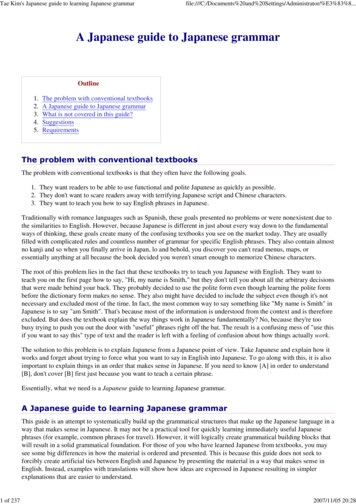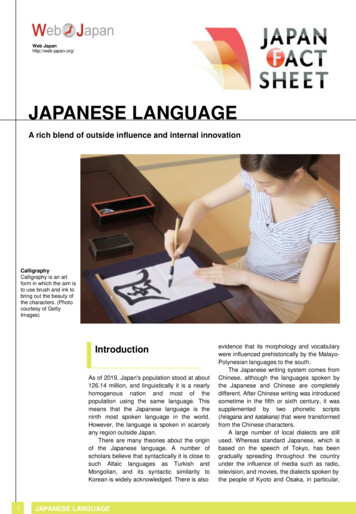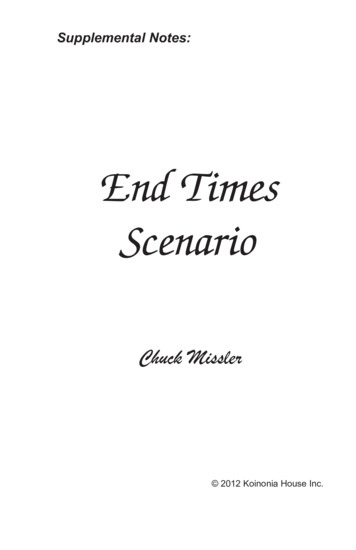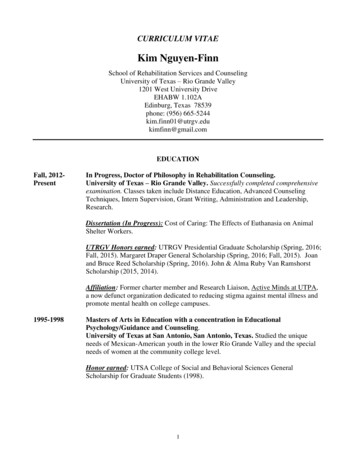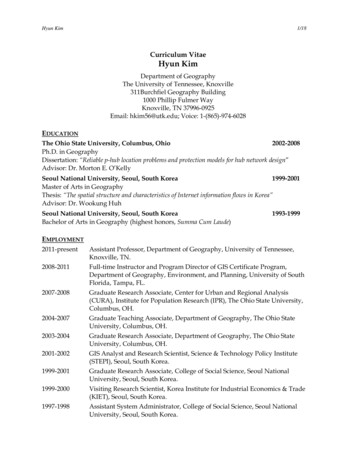
Transcription
Japanese Grammar GuideTae KimNovember 21, 2012
Contents1 Introduction1.1 The problem with conventional textbooks . . . . . . . . . . . . . . . . . . . . . .1.2 A Japanese guide to learning Japanese grammar . . . . . . . . . . . . . . . . . .1.3 Suggestions . . . . . . . . . . . . . . . . . . . . . . . . . . . . . . . . . . . . . . .111112132 The Writing System2.1 The Scripts . . . . . . . . . . . . . . . . . . . .2.2 Intonation . . . . . . . . . . . . . . . . . . . . .2.3 Hiragana . . . . . . . . . . . . . . . . . . . . .2.3.1 The Muddied Sounds . . . . . . . . . .2.3.2 The Small 「や」、「ゆ」、and 「よ」2.3.3 The Small 「つ」 . . . . . . . . . . . .2.3.4 The Long Vowel Sound . . . . . . . . .2.4 Katakana . . . . . . . . . . . . . . . . . . . . .2.4.1 The Long Vowel Sound . . . . . . . . .2.4.2 The Small 「ア、イ、ウ、エ、オ」 . .2.4.3 Some examples of words in Katakana .2.5 Kanji . . . . . . . . . . . . . . . . . . . . . . . .2.5.1 What is Kanji? . . . . . . . . . . . . . .2.5.2 Learning Kanji . . . . . . . . . . . . . .2.5.3 Reading Kanji . . . . . . . . . . . . . .2.5.4 Why Kanji? . . . . . . . . . . . . . . . .15151616181920202123242526262627283 Basic Grammar3.1 Basic Grammatical Structures . . . . . . . . . . . . . .3.2 Expressing State-of-Being . . . . . . . . . . . . . . . .3.2.1 Declaring something is so and so using 「だ」3.2.2 Conjugating to the negative state-of-being . . .3.2.3 Conjugating to the past state-of-being . . . . .3.2.4 Conjugation summary . . . . . . . . . . . . . .3.3 Introduction to Particles . . . . . . . . . . . . . . . . .3.3.1 Defining grammatical functions with particles .3.3.2 The 「は」 topic particle . . . . . . . . . . . .3.3.3 The 「も」 inclusive topic particle . . . . . . .3.3.4 The 「が」 identifier particle . . . . . . . . . .3.4 Adjectives . . . . . . . . . . . . . . . . . . . . . . . . .3.4.1 Properties of Adjectives . . . . . . . . . . . . .29292929313232333333353638383.
3.53.63.73.83.93.103.113.123.4.2 The na-adjective . . . . . . . . . . . . . . . . . .3.4.3 The i-adjective . . . . . . . . . . . . . . . . . . .3.4.4 An annoying exception . . . . . . . . . . . . . .Verb Basics . . . . . . . . . . . . . . . . . . . . . . . . .3.5.1 Role of Verbs . . . . . . . . . . . . . . . . . . . .3.5.2 Classifying verbs into ru-verbs and u-verbs . . .3.5.3 Appendix: iru/eru u-verbs . . . . . . . . . . . . .Negative Verbs . . . . . . . . . . . . . . . . . . . . . . .3.6.1 Conjugating verbs into the negative . . . . . . .Past Tense . . . . . . . . . . . . . . . . . . . . . . . . .3.7.1 Past tense for ru-verbs . . . . . . . . . . . . . .3.7.2 Past tense for u-verbs . . . . . . . . . . . . . . .3.7.3 Past-negative tense for all verbs . . . . . . . . .Particles used with verbs . . . . . . . . . . . . . . . . .3.8.1 The direct object 「を」 particle . . . . . . . . .3.8.2 The target 「に」 particle . . . . . . . . . . . . .3.8.3 The directional 「へ」 particle . . . . . . . . . .3.8.4 The contextual 「で」 particle . . . . . . . . . .3.8.5 When location is the topic . . . . . . . . . . . . .3.8.6 When direct object is the topic . . . . . . . . . .Transitive and Intransitive Verbs . . . . . . . . . . . . .3.9.1 Pay attention to particles! . . . . . . . . . . . . .Relative Clauses and Sentence Order . . . . . . . . . .3.10.1 Treating verbs and state-of-being like adjectives3.10.2 Using state-of-being clauses as adjectives . . .3.10.3 Using relative verb clauses as adjectives . . . .3.10.4 Japanese Sentence Order . . . . . . . . . . . .Noun-related Particles . . . . . . . . . . . . . . . . . . .3.11.1 The last three particles . . . . . . . . . . . . . .3.11.2 The Inclusive 「と」 particle . . . . . . . . . . .3.11.3 The Vague Listing 「や」 and 「とか」 particles3.11.4 The 「の」 particle . . . . . . . . . . . . . . . . .3.11.5 The 「の」 particle as explanation . . . . . . . .Adverbs and Sentence-ending particles . . . . . . . . .3.12.1 Properties of Adverbs . . . . . . . . . . . . . . .3.12.2 Sentence-ending particles . . . . . . . . . . . . .3.12.3 「ね」 sentence ending . . . . . . . . . . . . . .3.12.4 「よ」 sentence ending . . . . . . . . . . . . . .3.12.5 Combining both to get 「よね」 . . . . . . . . .4 Essential Grammar4.1 Polite Form and Verb Stems . . . . . . . . . .4.1.1 Not being rude in Japan . . . . . . . .4.1.2 The stem of verbs . . . . . . . . . . .4.1.3 Using 「〜ます」 to make verbs polite4.1.4 Using 「です」 for everything else . .4.1.5 「です」 is NOT the same as 8890
4.2 Addressing People . . . . . . . . . . . . . . . . . . . . . . . . . . . . . . . . . . .4.2.1 Referring to yourself . . . . . . . . . . . . . . . . . . . . . . . . . . . . . .4.2.2 Referring to others by name . . . . . . . . . . . . . . . . . . . . . . . . . .4.2.3 Referring to others with "you" . . . . . . . . . . . . . . . . . . . . . . . . .4.2.4 Referring to others in third person . . . . . . . . . . . . . . . . . . . . . .4.2.5 Referring to family members . . . . . . . . . . . . . . . . . . . . . . . . .4.3 The Question Marker . . . . . . . . . . . . . . . . . . . . . . . . . . . . . . . . . .4.3.1 Questions in polite form . . . . . . . . . . . . . . . . . . . . . . . . . . . .4.3.2 The question marker in casual speech . . . . . . . . . . . . . . . . . . . .4.3.3 「か」 used in relative clauses . . . . . . . . . . . . . . . . . . . . . . . .4.3.4 Using question words . . . . . . . . . . . . . . . . . . . . . . . . . . . . .4.4 Compound Sentences . . . . . . . . . . . . . . . . . . . . . . . . . . . . . . . . .4.4.1 Expressing a sequence of states . . . . . . . . . . . . . . . . . . . . . . .4.4.2 Expressing a sequence of verbs with the te-form . . . . . . . . . . . . . .4.4.3 Expressing reason or causation using 「から」 and 「ので」 . . . . . . .4.4.4 Using 「のに」 to mean "despite" . . . . . . . . . . . . . . . . . . . . . .4.4.5 Expressing contradiction using 「が」 and 「けど」 . . . . . . . . . . . .4.4.6 Expressing multiple reasons using 「し」 . . . . . . . . . . . . . . . . . .4.4.7 Expressing multiple actions or states using 「〜たりする」 . . . . . . . .4.5 Other uses of the te-form . . . . . . . . . . . . . . . . . . . . . . . . . . . . . . .4.5.1 Using 「〜ている」 for enduring states . . . . . . . . . . . . . . . . . . .4.5.2 Enduring state-of-being vs enduring state of action . . . . . . . . . . . . .4.5.3 Using 「〜てある」 for resultant states . . . . . . . . . . . . . . . . . . .4.5.4 Using the 「〜ておく」 form as preparation for the future . . . . . . . . .4.5.5 Using motion verbs ( く、来る) with the te-form . . . . . . . . . . . . . .4.6 Potential Form . . . . . . . . . . . . . . . . . . . . . . . . . . . . . . . . . . . . .4.6.1 Expressing the ability to do something . . . . . . . . . . . . . . . . . . . .4.6.2 The Potential Form . . . . . . . . . . . . . . . . . . . . . . . . . . . . . . .4.6.3 Potential forms do not have direct objects . . . . . . . . . . . . . . . . . .4.6.4 Are 「 える」 and 「聞こえる」 exceptions? . . . . . . . . . . . . . . .4.6.5 「ある」, yet another exception . . . . . . . . . . . . . . . . . . . . . . .4.7 Using する and なる with the に particle . . . . . . . . . . . . . . . . . . . . . . .4.7.1 Using 「なる」 and 「する」 for nouns and na-adjectives . . . . . . . . .4.7.2 Using 「なる」 with i-adjectives . . . . . . . . . . . . . . . . . . . . . . .4.7.3 Using 「なる」 and 「する」 with verbs . . . . . . . . . . . . . . . . . . .4.8 Conditionals . . . . . . . . . . . . . . . . . . . . . . . . . . . . . . . . . . . . . . .4.8.1 How to say "if" in Japanese . . . . . . . . . . . . . . . . . . . . . . . . . .4.8.2 Expressing natural consequence using 「と」 . . . . . . . . . . . . . . .4.8.3 Contextual conditionals using 「なら (ば)」 . . . . . . . . . . . . . . . . .4.8.4 General conditionals using 「ば」 . . . . . . . . . . . . . . . . . . . . . .4.8.5 Past conditional using 「たら (ば)」 . . . . . . . . . . . . . . . . . . . . .4.8.6 How does 「もし」 fit into all of this? . . . . . . . . . . . . . . . . . . . .4.9 Expressing "must" or "have to" . . . . . . . . . . . . . . . . . . . . . . . . . . . .4.9.1 When there's something that must or must not be done . . . . . . . . . .4.9.2 Using 「だめ」, 「いけない」, and 「ならない」 for things that must notbe done . . . . . . . . . . . . . . . . . . . . . . . . . . . . . . . . . . . . .4.9.3 Expressing things that must be done . . . . . . . . . . . . . . . . . . . . 32132134135137139140140140142
4.104.114.124.134.144.154.164.174.9.4 Various short-cuts for the lazy . . . . . . . . . . . . . . . . . .4.9.5 Saying something is ok to do or not do . . . . . . . . . . . . .Desire and Suggestions . . . . . . . . . . . . . . . . . . . . . . . . .4.10.1 How to get your way in Japan . . . . . . . . . . . . . . . . . .4.10.2 Verbs you want to do with 「たい」 . . . . . . . . . . . . . .4.10.3 Indicating things you want or want done using 「欲しい」 . .4.10.4 Making a motion to do something using the volitional form . .4.10.5 Making a motion to do something using the volitional form . .4.10.6 Making Suggestions using the 「ば」 or 「たら」 conditionalPerforming an action on a relative clause . . . . . . . . . . . . . . .4.11.1 The direct quote . . . . . . . . . . . . . . . . . . . . . . . . .4.11.2 The interpreted quote . . . . . . . . . . . . . . . . . . . . . .4.11.3 Using 「って」 as a casual version of 「と」 . . . . . . . . .Defining and Describing . . . . . . . . . . . . . . . . . . . . . . . . .4.12.1 The various uses of 「いう」 . . . . . . . . . . . . . . . . . .4.12.2 Using 「いう」 to define . . . . . . . . . . . . . . . . . . . .4.12.3 Using 「いう」 to describe anything . . . . . . . . . . . . . .4.12.4 Rephrasing and making conclusions with 「という」 . . . .4.12.5 Using 「って」 or 「て」 for 「という」 . . . . . . . . . . .4.12.6 Saying 「ゆう」 instead of 「いう」 . . . . . . . . . . . . . .Trying something out or attempting to do something . . . . . . . . .4.13.1 Let's try some stuff . . . . . . . . . . . . . . . . . . . . . . . .4.13.2 To try something out . . . . . . . . . . . . . . . . . . . . . . .4.13.3 To attempt to do something . . . . . . . . . . . . . . . . . . .Giving and Receiving . . . . . . . . . . . . . . . . . . . . . . . . . .4.14.1 Japanese people like gifts . . . . . . . . . . . . . . . . . . . .4.14.2 When to use 「あげる」 . . . . . . . . . . . . . . . . . . . .4.14.3 When to use 「くれる」 . . . . . . . . . . . . . . . . . . . .4.14.4 When to use 「もらう」 . . . . . . . . . . . . . . . . . . . .4.14.5 Asking favors with 「くれる」 or 「もらえる」 . . . . . . . .Making requests . . . . . . . . . . . . . . . . . . . . . . . . . . . . .4.15.1 Politely (and not so politely) making requests . . . . . . . . .4.15.2 「〜ください」- a special conjugation of 「くださる」 . .4.15.3 Using 「〜ちょうだい」 as a casual request . . . . . . . . .4.15.4 Using 「〜なさい」 to make firm but polite requests . . . . .4.15.5 The Command Form . . . . . . . . . . . . . . . . . . . . . . .4.15.6 Negative Command . . . . . . . . . . . . . . . . . . . . . . .Numbers and Counting . . . . . . . . . . . . . . . . . . . . . . . . .4.16.1 The Number System . . . . . . . . . . . . . . . . . . . . . . .4.16.2 Counting and Counters . . . . . . . . . . . . . . . . . . . . .4.16.3 Using 「 」 to show order . . . . . . . . . . . . . . . . . . .Casual Patterns and Slang . . . . . . . . . . . . . . . . . . . . . . .4.17.1 Basic Principles of Slang . . . . . . . . . . . . . . . . . . . .4.17.2 Sentence ordering and particles . . . . . . . . . . . . . . . .4.17.3 Using 「じゃん」 instead of 「じゃない」 to confirm . . . .4.17.4 Using 「つ」 for 「という」 . . . . . . . . . . . . . . . . . .4.17.5 Using 「ってば」 and 「ったら」to show exasperation . . 77179180181183184184187192192192194195197199
4.17.6 Using 「なんか」 just about everywhere . . . . .4.17.7 Showing contempt for an action with 「〜やがる」4.18 More sentence-ending particles . . . . . . . . . . . . . . .4.18.1 「な」 and 「さ」 sentence-ending particles . . .4.18.2 「かい」 and 「だい」 sentence-ending particles4.18.3 Gender-specific sentence-ending particles . . . .4.18.4 That's a wrap! . . . . . . . . . . . . . . . . . . . .5 Special Expressions5.1 Causative and Passive Verbs . . . . . . . . . . . . . . . . . . . . . . . . . . . . .5.1.1 Causative Verbs . . . . . . . . . . . . . . . . . . . . . . . . . . . . . . . .5.1.2 Passive Verbs . . . . . . . . . . . . . . . . . . . . . . . .
3.4.2 Thena-adjective . . . . . . . . . . . . . . . . . . . . . . . . . . . . . . . . 38 3.4.3 Thei-adjective .
